The following blog was taken from an in-depth interview with Master Carver and Polynesian Navigator, Kawika Eskaran of Laie, Hawaii, who along with Sione Tuione Pulotu, guided the design and construction of the Iosepa, a 57′ double hulled sailing canoe modeled in style and function after the ancient canoes utilized by Hawaiians to travel the seas. The Iosepa was sponsored and built through a cooperative effort between Brigham Young University – Hawaii and The Polynesian Cultural Center. When it is not sailing, the Iosepa is housed at The Polynesian Cultural Center.
Traditional Polynesian Navigation
……..Kawika describes the navigational skills used during a historic trip taken in 2007 where they delivered the Alingano Maisu, a handcrafted large canoe built in the ancient Polynesian style to “Papa” Mau Pialug as a gift for his invaluable contributions in reawakening the knowledge of wayfinding or non-instrument navigation among the Hawaiians and other Polynesians. The sister ship on this voyage was the Hōkūleʻa.
“In navigating by the stars, you use certain sections of the Heavens as the sky rotates in the evening. There are different starlines that come up and others that are set.”
“The measuring points for this system are your own digits on your hand and the spacing between them in reference to layout of the constellations. Once you calibrate your hand size, you utilize your hand to get exact bearings throughout the evening.”
A hands-on experience
Kawika explained how this worked. “Imagine the horizon of the ocean before you”, he explained. “As you are sailing, you would use the North Star as your reference point. At the point we were sailing near the equator, the North Star is 6o above horizon.”
“We calibrated our hands before we left home,” he said, while extending his arm to full length in front of him, and placing his right hand with the palm out and with his thumb extended. “From the bottom on my hand here to the center of my fingers here, is 6o. For me that is roughly 2o per fingers.
“So, I placed the bottom of my hand on the horizon,” he continued, “and then looked for the North Star. I would then place the star right at that point on my fingers that equaled 6o. Then throughout the night I would make sure that we are on that mark.”
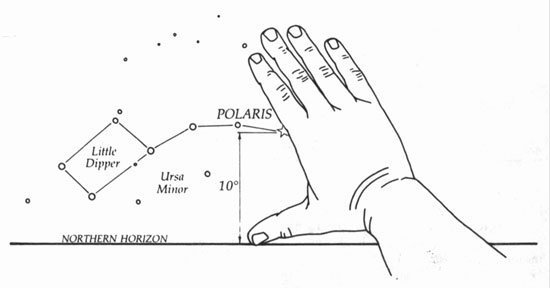
The hand method used to find the altitude of Polaris Photo courtesy of the Journal of the Polynesian Society
A team effort
“Now, say the wind is blowing and the canoe is always wanting to come up into the wind, Kawika continued. “Sometimes, to keep our mark, we would want the canoe to stay downwind. So all night long you’re fighting the wind, and the want of the canoe to head into that wind. To counter this you’ll always trying to steer it down. Sometimes the currents actually work with you too much and you end up going too far down, through steering.”
To measure correctly, Kawika demonstrated, “I would need to square my shoulders to the canoe, with my nose straight forward. So as long as my hand is pointing to the North Star, we will be good. If we start falling down and start pointing into the wind, my hand will be off centered and I will say, bring the canoe up.”
Kawika shared that six individuals beside himself traveling on the Hōkūleʻa and Alingano Maisu were assigned each night to keep individual measurements, assuring that the two vessels kept on course.
Learn more at The PCC
Want to learn more about the knowledge and skills our Polynesian ancestors used to travel the seas? Come see the mighty Iosepa (E-yo-se-pah,) a double hulled Polynesian vessel designed and built to ancient specifications at Brigham Young University – Hawaii and housed at the adjoining Polynesian Cultural Center.
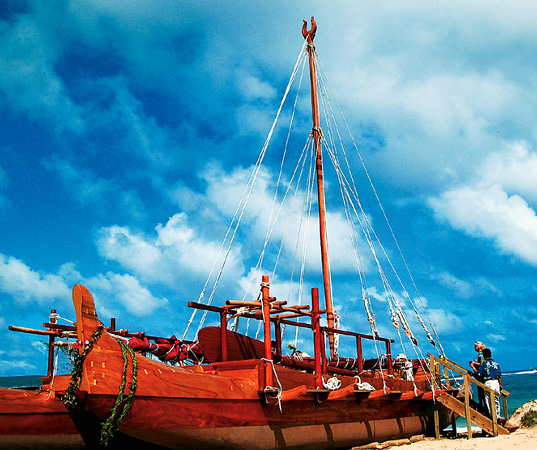
The beautiful Iosepa, a double hulled Polynesian sailling canoe, is housed at The Polynesian Cultural Center – photo courtesy of BYU Magazine
Bring the power and beauty home
Own your own piece of navigational history with a selection of hand carved replicas, historical books or with a hand carved replica of a Polynesian canoe from the official online store of the Polynesian Cultural Center. Click here to see more!
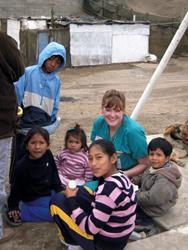
Nina S Jones
Nina Jones, a mainland gal from way back, is now a transplanted Islander. With her husband of 40+ years, she volunteers at the Polynesian Cultural Center. Her hobbies include swimming, traveling, studying and writing about what she is learning from the various Polynesian cultures. Her blogs focus on their history, beliefs, practices and – as an added bonus – delicious food! To her, Polynesia is not just a place to visit, it is a way to live and she is very honored to be able to be a part of this amazing world.

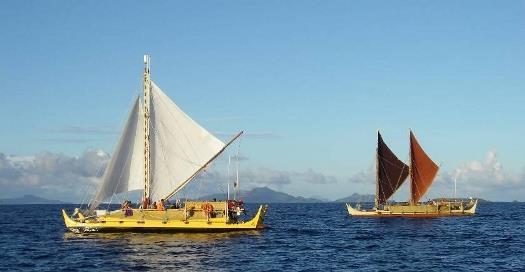
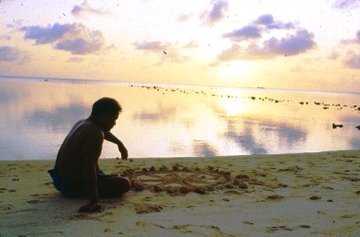
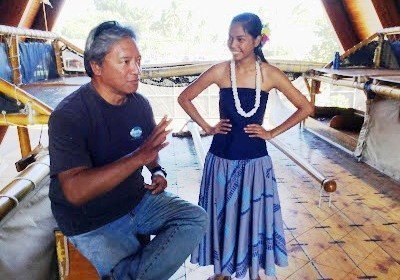

Recent Comments